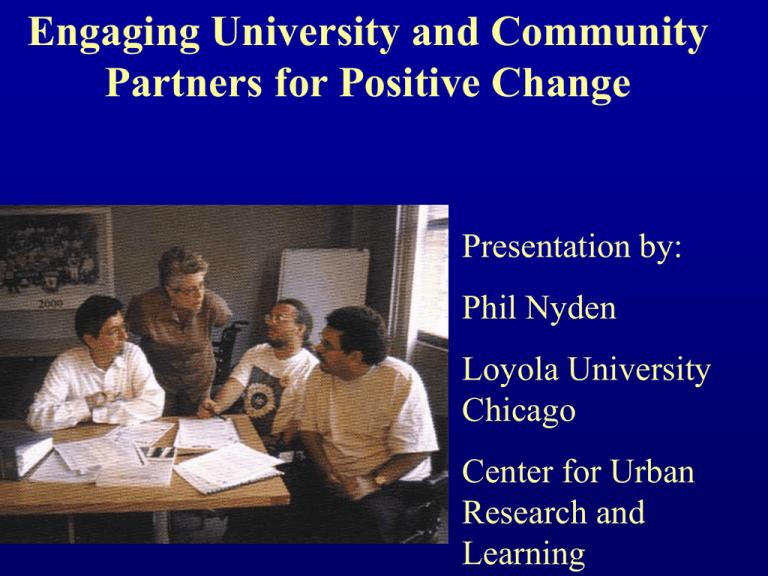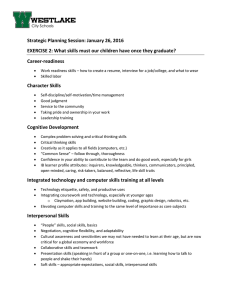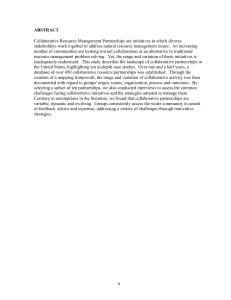Engaging University and Community Partners for Positive Change Presentation by: Phil Nyden
advertisement

Engaging University and Community Partners for Positive Change Presentation by: Phil Nyden Loyola University Chicago Center for Urban Research and Learning Overview CURL model barriers to university-community partnerships factors that break down barriers and facilitate partnerships what is the attractiveness to collaborative research? …to faculty? …to students? …to universities? …to community partners? what strategies can be used to promote and/or create strong, sustained partnerships? Loyola University of Chicago Center for Urban Research & Learning ??? Loyola University of Chicago Center for Urban Research and Learning (CURL) Collaborative Research Model not research on the community, but research with the community recognizes knowledge in the university and knowledge in the community “adds chairs” at the research table Community as partners at all levels of research conceptualization designing the methodology collecting data analyzing data writing reports dissemination of results Loyola University of Chicago Center for Urban Research & Learning CURL Team-Based Research & Action Projects faculty graduate students undergraduate students community organization leaders/ staff/members CURL staff Loyola University of Chicago Center for Urban Research & Learning What are the barriers to effective communityuniversity partnerships? Barriers: the discipline defines research priorities university-based research focuses on furthering knowledge in the discipline social change is not the primary goal the theoretical is favored over the practical Barriers: Community-based research is seen as biased without unbiased “outside” researchers, data analysis might be manipulated to serve political ends involving “representatives” of the population to be studied in the research process raises potential of bias in collecting data Barriers: Community-based research is perceived as parochial research is seen as limited in scope and less powerful in its application traditional academic culture gives higher value to the “national or global” than to the “local” Barriers: Tenure and promotion guidelines publications and contributions to “the field” favored over impact on society “demonstrated contributions to the improved quality of life in society” not generally a category on the balance sheet indifference and even hostility to community engagement Loyola University of Chicago Center for Urban Research & Learning Barriers: Community’s past experience with university research only the object of research, not a participant in research limited practical relevance to community development or improved service delivery more of thumbs up/thumbs down evaluation research of existing programs Loyola University of Chicago Center for Urban Research & Learning On the other hand, there are factors that can break down barriers and facilitate partnerships For the community, collaborative partnerships have potential for building increased capacity gain familiarity with the research process; knows how to manage research develop independent research skills improve practices in community organizations For the community, collaborative partnerships have potential for building increased capacity move from research to action: gets information into hands of constituencies For the university, partnerships also build capacity promote interdisciplinary research create a stimulating environment for faculty and students engage in research that is used and does not sit on a library shelf increase visibility of university in community, region, nation, world For the university and the community, partnerships are beneficial integrate university and community knowledge into the learning environment build an environment where learning takes place in multiple directions provide an understanding of connection among knowledge, power, and social change produce an understanding of what is possible. For university faculty, partnerships... provide a “real” environment for teaching and learning produce a dynamic learning environment with challenges, unpredictability, & constant questioning (the qualities of a good classroom) For university faculty, partnerships... open the door to more research opportunities than can be completed in lifetime give access to significant research funding and publication opportunities For university students, working in university-community partnerships provide... an antidote for civic disengagement you can have an impact demystifies the policy making process For university students, working in university-community partnerships helps to... gives a real face to social issues; they are no longer academic abstractions see connections among disciplines A Closer Look at Center for Urban Research and Learning (CURL) Support for team members faculty fellowships graduate fellowships undergraduate--fellowships and course credit community fellowships CURL staff Loyola University of Chicago Center for Urban Research & Learning Funding government-funded grants foundation-supported projects endowment leveraging university resources matching resources for faculty released time student fellowship awards and course credit volunteer time Loyola University of Chicago Center for Urban Research & Learning Examples of CURL Collaborative University-Community Projects CURL Project: What creates and sustains racially/ethnically diverse communities? concept emerged from activistresearcher discussions solution-focused, not problemfocused policy maker and activist attention media interest in research Center for Urban Research & Learning CURL Project: What creates and sustains racially/ethnically diverse communities? two-types of communities: diverse by design diverse by circumstance (new immigrant groups) changing way advocates promote diversity connection to work on sustaining mixedincome communities CURL Project: Impact of Welfare Reform on Mixed-Income Communities idea developed from breakfast meetings with different community partners linked CURL with advocacy organization and traditional social service agency three reports and impact on state legislation CURL Project: Developing Culturally Sensitive Approaches to Addressing Domestic Violence community organization was aware of CURL’s other collaborative work needed evaluation of impact of its programs CURL Project: Developing Culturally Sensitive Approaches to Addressing Domestic Violence connection to national network of organizations serving South Asian community exploring expansion of project: international organizations serving women in other ethnic communities CURL Project: Documenting Changes in Affordable Housing gentrifying community arguments among developers, affordable housing advocates, and city re: extent of affordable housing loss CBO lobbied state representative to provide funding for study Loyola University of Chicago Center for Urban Research & Learning CURL Project: Documenting Changes in Affordable Housing advisory committee from all sectors of community data from report viewed as credible by all involved other communities interested in research Tenure and Occupancy in Uptown Census 2000 Renter Occupied Units 72% Vacant Units For Rent 61% Vacant Units 5% Vacant For Sale 8% "Other" Vacant Units 25% Owner Occupied Units 23% Vacant Units Rented or Sold 6% Creating a regional network to promote universitycommunity/government partnerships Policy Research Action Group (PRAG) Created in the late 1980s developed from the “grassroots” by activist faculty and community leaders collaborative research model four universities more than 15 community partners over 175 collaborative projects www.luc.edu/depts/curl/prag Policy Research Action Group (PRAG) produced an environment of collaboration in Chicago collaborative and “participatory research” still minority research approaches, but this provided visibility and a support network became a “self-help” network contributed to the development of more than six collaborative centers in Chicago if funding disappears, still have network now Lessons learned in building and sustaining partnerships Lessons learned in building and sustaining partnerships start small concentrate on projects that will produce tangible outcomes, not just the process itself develop “interdependent partnerships” accomplish end results that individuals or individual institutions could not achieve on their own organize/match expertise to produce a sum that is greater than its parts recruit people who are committed to the project and the process Loyola University of Chicago Center for Urban Research & Learning Lessons learned in building and sustaining partnerships create a partnership culture everyone shares credit help each other promote work in their work/institutional setting open environment: welcome new members to partnership (individual/institutional) create trust Loyola University of Chicago Center for Urban Research & Learning Lessons learned in building and sustaining partnerships harness the tensions of universitycommunity/government relationships both academics and community activists willing to criticize and argue—this is OK, it provides… different perspectives helpful in understanding complex issues a more complete knowledge base also, it is not community-driven research or university-driven research; it’s collaborative research Loyola University of Chicago Center for Urban Research & Learning Lessons learned in building and sustaining partnerships develop resources to sustain the collaboration political support (from institutional leaders) funding grants endowments income/funding from multiple sources (diversification) fellowships—university (faculty & students) and community ongoing centers/networks staff dedicated to developing & sustaining collaboration “leverage” other resources with what funding/resources you do get Loyola University of Chicago Center for Urban Research & Learning Lessons learned in building and sustaining partnerships understand that individuals are motivated to participate by factors other than just money collaborations enable participants… to become part of social-change process to connect with like-minded colleagues to join a support network which provides guidance on research projects Loyola University of Chicago Center for Urban Research & Learning Some strategies for building on strengths and overcoming obstacles visibility and information sharing publications web presence reports books periodicals Some strategies for building on strengths and overcoming obstacles media attention Some strategies for building on strengths and overcoming obstacles working groups researchers & practitioners citywide or regional Some strategies for building on strengths and overcoming obstacles doing “political work” within disciplines visibility of collaborative methods “translating research” for use by practitioners building a following of people experienced in partnerships emphasizing that this is “research with a constituency” Strategies for change: change hiring & tenure and promotion procedures/guidelines reduce discipline-bound control of faculty personnel policies increase university-wide incentives to promote engaged scholarship. creating a national and international networks of peers to judge faculty doing collaborative research service as a primary, not residual, evaluation category Strengthen existing or create new collaborative centers that can serve multiple functions as … institutional advocates for collaborative research places where multiple collaborative efforts can be concentrated and made more visible brokers of information and resources technical assistance centers for collaborative projects Creating new collaborative centers that can serve multiple functions as … alternative socialization venues for faculty students, and community partners conveners of collaborative researchers to discuss ongoing projects Loyola University of Chicago Center for Urban Research & Learning Gains have been made in promoting collaborative research in universities & the community, but there is still substantial work to be done.

